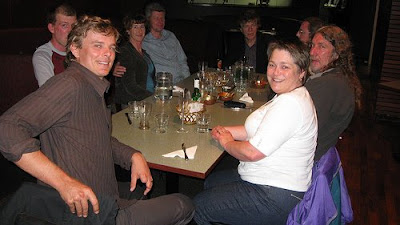 Earlier in December I attended three days of SLENZ workshops that aimed to put substance to the proposal for a virtual birth unit in Second Life that Deborah Davis and I have had accepted. Up to then, I had a vague idea of how the birth unit could be used in midwifery education but didn't really know how it would look and the practicalities of its development.
Earlier in December I attended three days of SLENZ workshops that aimed to put substance to the proposal for a virtual birth unit in Second Life that Deborah Davis and I have had accepted. Up to then, I had a vague idea of how the birth unit could be used in midwifery education but didn't really know how it would look and the practicalities of its development.Working together
The process of working together was very interesting. The SLENZ group is made up of educators, Second Life experts and developers, and of course we all have our own opinions about things. But following much discussion we came to agreement - it was a great example of how people can negotiate a diversity of opinions and professional knowledge.
I especially valued Leigh Blackall's caution about how this project can incorporate students who do not have access to the broadband width or computers that support Second Life. I have also been thinking a lot about a comment John Waugh made to me - he maintains I need to immerse myself in Second Life. I do not agree, especially as Second Life is not my favorite web 2.0 networking tool. I believe I need the skills to be able to mentor students and health professionals in Second Life, but I do not have the time or inclination to spend hours and hours becoming the Second Life guru that John is.
 Three stages of birth unit project:
Three stages of birth unit project:Stage One
- Development of the birth unit according to specifications of Birth Unit Principles. This will include sign posts that explain the features of the unit and why they were chosen according to research eg links to research about the benefits of water in labour next to birthing pool.
- The unit should be ready for 'testing' by the end of February.
- Should be appropriate for first year students to look around, with lecturer taking them on the tour and explaining what is going on. This can happen any time during 2009 at a time convenient for both students and lecturers - to be tested with students at home in order to see how students cope away from campus, especially those in rural locations.
- Comic strip and video that tell the story of the birth unit especially for third year students who do not have access to the Internet - to be developed as alternative media to Internet that can be posted to student.
- Normal birth scenario (from early labour until birth of placenta) developed that student works her way through: two people are required, midwife and woman which can either be lecturer and student, or student and student. This should be ready for second year students to test during 'integration week' at the end of May and tested in a computer laboratory. Can also be tested with third years in computer laboratory in June seminar.
- This scenario will not be automatized - students will have to work with another person. This may be an opportunity for networked learning in Second Life eg the student works through the scenario with another Second Lifer (not necessarily a student).
 Stage Two
Stage Two- Development of the normal birth scenario so that students have to make decisions about the birth that is not going as normal as expected eg labour is long, or woman becomes dehydrated.
- To be ready end of October for second year 'integration week' and third year seminar in November. To be tested in computer laboratory.
- Alternative media.
- Development of scenario into abnormality and emergency outcomes eg neonatal resuscitation and transfer to hospital.
- To be ready end of October for second year 'integration week' and third year seminar in November. To be tested in computer laboratory.
- Alternative media.
User story
I have developed the initial user story based around the decision points in labour that are advocated by the New Zealand College of Midwives.

 Things to do
Things to do- Get plans for birth unit to Aaron Griffths so he can start working on development as soon as possible.
- Deb and I to start writing about the birth unit, coming up with stories about why we have chosen the features we have chosen.
- Start to plan research outputs.
1 comment:
Great photos linked in here to the Slenz group Sarah. I know the names and what they do, really interesting to see them in real life here.
Post a Comment